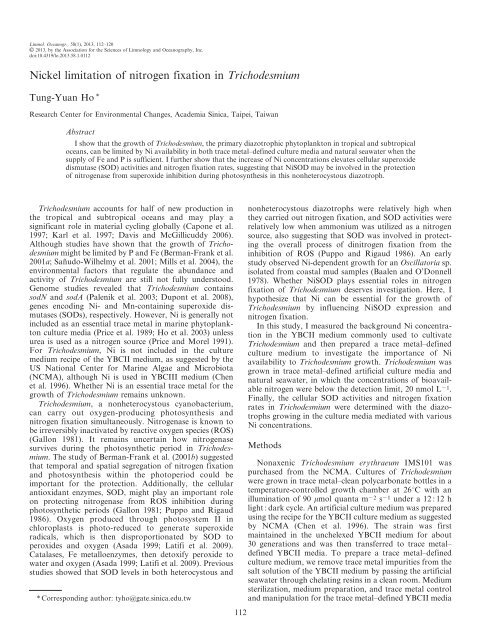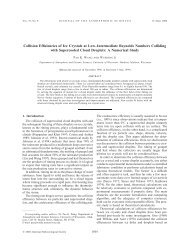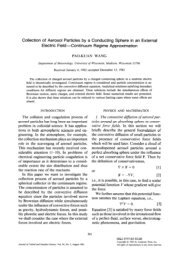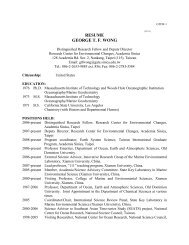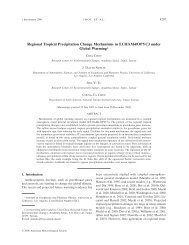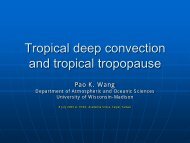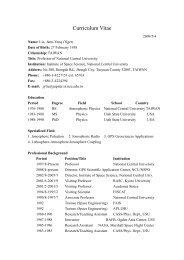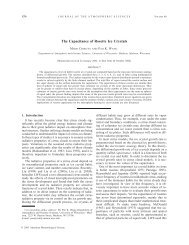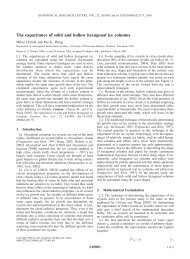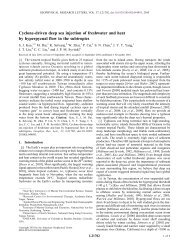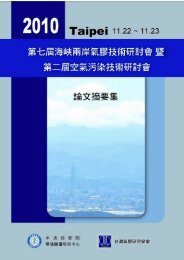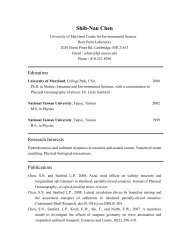Ho, Tung-Yuan. Nickel limitation of nitrogen ... - Academia Sinica
Ho, Tung-Yuan. Nickel limitation of nitrogen ... - Academia Sinica
Ho, Tung-Yuan. Nickel limitation of nitrogen ... - Academia Sinica
- No tags were found...
Create successful ePaper yourself
Turn your PDF publications into a flip-book with our unique Google optimized e-Paper software.
Limnol. Oceanogr., 58(1), 2013, 112–120E2013, by the Association for the Sciences <strong>of</strong> Limnology and Oceanography, Inc.doi:10.4319/lo.2013.58.1.0112<strong>Nickel</strong> <strong>limitation</strong> <strong>of</strong> <strong>nitrogen</strong> fixation in Trichodesmium<strong>Tung</strong>-<strong>Yuan</strong> <strong>Ho</strong> *Research Center for Environmental Changes, <strong>Academia</strong> <strong>Sinica</strong>, Taipei, TaiwanAbstractI show that the growth <strong>of</strong> Trichodesmium, the primary diazotrophic phytoplankton in tropical and subtropicaloceans, can be limited by Ni availability in both trace metal–defined culture media and natural seawater when thesupply <strong>of</strong> Fe and P is sufficient. I further show that the increase <strong>of</strong> Ni concentrations elevates cellular superoxidedismutase (SOD) activities and <strong>nitrogen</strong> fixation rates, suggesting that NiSOD may be involved in the protection<strong>of</strong> <strong>nitrogen</strong>ase from superoxide inhibition during photosynthesis in this nonheterocystous diazotroph.Trichodesmium accounts for half <strong>of</strong> new production inthe tropical and subtropical oceans and may play asignificant role in material cycling globally (Capone et al.1997; Karl et al. 1997; Davis and McGillicuddy 2006).Although studies have shown that the growth <strong>of</strong> Trichodesmiummight be limited by P and Fe (Berman-Frank et al.2001a; Sañudo-Wilhelmy et al. 2001; Mills et al. 2004), theenvironmental factors that regulate the abundance andactivity <strong>of</strong> Trichodesmium are still not fully understood.Genome studies revealed that Trichodesmium containssodN and sodA (Palenik et al. 2003; Dupont et al. 2008),genes encoding Ni- and Mn-containing superoxide dismutases(SODs), respectively. <strong>Ho</strong>wever, Ni is generally notincluded as an essential trace metal in marine phytoplanktonculture media (Price et al. 1989; <strong>Ho</strong> et al. 2003) unlessurea is used as a <strong>nitrogen</strong> source (Price and Morel 1991).For Trichodesmium, Ni is not included in the culturemedium recipe <strong>of</strong> the YBCII medium, as suggested by theUS National Center for Marine Algae and Microbiota(NCMA), although Ni is used in YBCIII medium (Chenet al. 1996). Whether Ni is an essential trace metal for thegrowth <strong>of</strong> Trichodesmium remains unknown.Trichodesmium, a nonheterocystous cyanobacterium,can carry out oxygen-producing photosynthesis and<strong>nitrogen</strong> fixation simultaneously. Nitrogenase is known tobe irreversibly inactivated by reactive oxygen species (ROS)(Gallon 1981). It remains uncertain how <strong>nitrogen</strong>asesurvives during the photosynthetic period in Trichodesmium.The study <strong>of</strong> Berman-Frank et al. (2001b) suggestedthat temporal and spatial segregation <strong>of</strong> <strong>nitrogen</strong> fixationand photosynthesis within the photoperiod could beimportant for the protection. Additionally, the cellularantioxidant enzymes, SOD, might play an important roleon protecting <strong>nitrogen</strong>ase from ROS inhibition duringphotosynthetic periods (Gallon 1981; Puppo and Rigaud1986). Oxygen produced through photosystem II inchloroplasts is photo-reduced to generate superoxideradicals, which is then disproportionated by SOD toperoxides and oxygen (Asada 1999; Latifi et al. 2009).Catalases, Fe metalloenzymes, then detoxify peroxide towater and oxygen (Asada 1999; Latifi et al. 2009). Previousstudies showed that SOD levels in both heterocystous and* Corresponding author: tyho@gate.sinica.edu.tw112nonheterocystous diazotrophs were relatively high whenthey carried out <strong>nitrogen</strong> fixation, and SOD activities wererelatively low when ammonium was utilized as a <strong>nitrogen</strong>source, also suggesting that SOD was involved in protectingthe overall process <strong>of</strong> di<strong>nitrogen</strong> fixation from theinhibition <strong>of</strong> ROS (Puppo and Rigaud 1986). An earlystudy observed Ni-dependent growth for an Oscillatoria sp.isolated from coastal mud samples (Baalen and O’Donnell1978). Whether NiSOD plays essential roles in <strong>nitrogen</strong>fixation <strong>of</strong> Trichodesmium deserves investigation. Here, Ihypothesize that Ni can be essential for the growth <strong>of</strong>Trichodesmium by influencing NiSOD expression and<strong>nitrogen</strong> fixation.In this study, I measured the background Ni concentrationin the YBCII medium commonly used to cultivateTrichodesmium and then prepared a trace metal–definedculture medium to investigate the importance <strong>of</strong> Niavailability to Trichodesmium growth. Trichodesmium wasgrown in trace metal–defined artificial culture media andnatural seawater, in which the concentrations <strong>of</strong> bioavailable<strong>nitrogen</strong> were below the detection limit, 20 nmol L 21 .Finally, the cellular SOD activities and <strong>nitrogen</strong> fixationrates in Trichodesmium were determined with the diazotrophsgrowing in the culture media mediated with variousNi concentrations.MethodsNonaxenic Trichodesmium erythraeum IMS101 waspurchased from the NCMA. Cultures <strong>of</strong> Trichodesmiumwere grown in trace metal–clean polycarbonate bottles in atemperature-controlled growth chamber at 26uC with anillumination <strong>of</strong> 90 mmol quanta m 22 s 21 under a 12 : 12 hlight : dark cycle. An artificial culture medium was preparedusing the recipe for the YBCII culture medium as suggestedby NCMA (Chen et al. 1996). The strain was firstmaintained in the unchelexed YBCII medium for about30 generations and was then transferred to trace metal–defined YBCII media. To prepare a trace metal–definedculture medium, we remove trace metal impurities from thesalt solution <strong>of</strong> the YBCII medium by passing the artificialseawater through chelating resins in a clean room. Mediumsterilization, medium preparation, and trace metal controland manipulation for the trace metal–defined YBCII media
<strong>Nickel</strong> limits Trichodesmium N 2 fixation 113Table 1. The concentrations (nmol L 21 ) <strong>of</strong> dissolved trace metals in unchelated YBCII medium, chelated YBCII medium (beforeadding trace metals), and the surface seawater collected in the SCS. It should be noted that the background concentrations <strong>of</strong> trace metalsin the unchelexed artificial culture medium can vary from time to time and from laboratory to laboratory because the culture mediumprepared in different laboratories by different people with the use <strong>of</strong> different brands <strong>of</strong> chemicals would cause different levels <strong>of</strong>contamination through the preparation procedures.Concentration (n 5 3)Culture mediumNi Fe Mn Zn Cu Co CdUnchelated YBC II 13064 8.960.3 7.060.6 1361 3.160.2 0.1160.004 0.8060.04Chelated YBC II 0.0460.01 0.1560.01 0.0260.02 0.1560.3 0.1060.2 0.00560.001 0.01060.001SCS surface water 2.060.01 0.1460.06 3.060.05 0.7460.3 1.360.06 0.02760.005 0.1060.005generally follows the procedures for preparing trace metal–defined culture media (Price et al. 1989; <strong>Ho</strong> et al. 2003).Previous studies showed that cell volume was closelycorrelated with carbon content in various marine phytoplankton(Thompson et al. 1991; Verity et al. 1992;Montagnes et al. 1994), indicating that cell volume is areliable parameter for the estimate <strong>of</strong> biomass or growthrates in phytoplankton, including Trichodesmium (Tuit et al.2004). Because the Trichodesmium strain used in this studyexisted in a single trichome state during the growth period,the total cell volume <strong>of</strong> Trichodesmium samples can bedetermined by a particle counter. I made an extra effort inthis study to evaluate the accuracy <strong>of</strong> total cell volumeobtained by Coulter Counter (Beckman Coulter, Multisizer3). The total cellular volume <strong>of</strong> the same Trichodesmiumculture samples were repeatedly determined simultaneouslyby Coulter Counter and a microscope (Carl Zeiss, AxioImager A2) with hemocytometer (Marienfeld, Neubaueer).Using the microscope and hemocytometer, the lengths andwidths <strong>of</strong> all trichomes per unit sample volume weremeasured, and the total cell volume was estimated bymultiplying the total length <strong>of</strong> trichomes with the crosssectionalarea. Overall, the precision <strong>of</strong> the replicateanalysis <strong>of</strong> the total cell volume obtained by the CoulterCounter was much better than the microscope – 1–5% and30–60%, respectively. The total cellular volume obtained bythe particle counter was comparable or slightly lower thanthe value obtained by the microscope with hemocytometer,indicating that the particle counter can be a reliable method<strong>of</strong> estimating the total cell volume <strong>of</strong> Trichodesmium.We observed by microscope that individual cell volumevaried significantly from cell to cell in each trichome.<strong>Ho</strong>wever, the variations <strong>of</strong> the averaged cell volume <strong>of</strong> theTrichodesmium grown in various Ni treatments wereanalytically insignificant because the individual variationswere mostly canceled out by dividing total cell volume bytotal cell numbers. Additionally, we observed consistenttrichome size during growth periods in different Nitreatments, suggesting that average cell size was comparableduring the growth period in this study. Thus, theincrease in total cellular volume can be a good estimate <strong>of</strong>the increase in total cell numbers or the increase in growthrates. Total cell numbers can be estimated by using theconversion factor <strong>of</strong> average cell volume per cell, whichmostly ranged from 200 to 250 mm 3 per cell in this study.We also observed that chlorophyll a (Chl a) concentrationsby fluorometric analysis (Turner Designs) exhibited stronglinear correlations with total cell volume measured, withcorrelation coefficients (r 2 ) up to 0.99 (p , 0.01) during theexponential phase. The conversion factor <strong>of</strong> cell volume toChl a was about 0.10 ng chlorophyll per 10 6 mm 3 <strong>of</strong> cellvolume.To determine intracellular trace metal quotas accurately,we modified the concentrations <strong>of</strong> Fe and ethylenediaminetetraaceticacid (EDTA) in the original YBCII culturemedium (Chen et al. 1996). It is likely that high levels <strong>of</strong> Feadded to the culture medium would be precipitated andadsorbed on the algal surface (<strong>Ho</strong> et al. 2003). Weincreased the EDTA concentration from 2 to 20 mmol L 21and decreased the total Fe concentration from 400 to100 nmol L 21 in YBCII medium so that the inorganic Feconcentration was about 500 pmol L 21 (<strong>Ho</strong> et al. 2003).Unless otherwise noted, Trichodesmium was grown underthe modified trace metal–defined medium. Initial phosphateconcentration in the medium was 50 mmol L 21 ;bioavailable <strong>nitrogen</strong> was not added, and the backgroundconcentrations <strong>of</strong> nitrate and nitrite were below thedetection limit in the culture medium. Other trace metalconcentrations in the medium were 20, 4, 1, 2.5, and11 nmol L 21 for Mn, Zn, Cu, Co, and Mo, respectively.Cells were grown twice for at least 10 generations in thetrace metal–defined culture medium with a 50 nmol L 21 Niconcentration and then transferred to new media enrichedwith total dissolved Ni concentrations varying from 0 to400 nmol L 21 .Trace metal concentrations in natural seawater andculture media were measured by an automated pretreatmentmethod with a high-resolution inductively coupledplasma spectrometer (HR-ICPMS) (<strong>Ho</strong> et al. 2010). Thenatural seawater used in this study was collected at an<strong>of</strong>fshore basin site in the northern South China Sea (SCS)by using trace metal–clean techniques and using TefloncoatedGo Flo bottles (General Oceanics) mounted on aTeflon-coated rosette equipped with Kevlar wire. The totaldissolved Fe and Ni concentrations in the natural waterwere 0.14 and 2.0 nmol L 21 , respectively (Table 1).To determine intracellular trace metal quotas, culturedcells were harvested onto acid-washed 25 mm polycarbonatefilters with a 10 mm pore size in a class 100 trace metal–clean laboratory during the light portion <strong>of</strong> the light–darkcycle. The filtered cells were rinsed with trace metal–cleanseawater, the chelexed seawater, to remove the culturemedium residue. The trace metal–clean seawater is theseawater passed through a column filled with chelex 100
114 <strong>Ho</strong>resins, in which trace metal concentrations are extremelylow (Table 1). Trace metal quotas in the phytoplanktonand trace metal concentrations in the seawater were thendetermined using a HR-ICPMS (Thermo Scientific ElementXR) fitted with a desolvation system (ElementalScientific). The Fe quotas in the cells we have observedwere around 10 mmol mol 21 P, which was slightly higherthan the Fe quotas observed in other marine phytoplanktongrown in a low-Fe culture medium (<strong>Ho</strong> et al. 2003),thus indicating that extracellular Fe adsorption on Trichodesmiumwas insignificant. The details <strong>of</strong> the analyticalprecision, accuracy, and detection limits <strong>of</strong> the ICPMSmethod for seawater and phytoplankton were described inour previous studies (<strong>Ho</strong> et al. 2003, 2007, 2010).Two Ni enrichment experiments in natural seawater werecarried out in this study. First, 10 mL <strong>of</strong> the culturedspecies Trichodesmium IMS 101, maintained in themodified YBCII medium enriched with 50 nmol L 21 Ni,was inoculated in 1 liter <strong>of</strong> natural seawater collected fromthe surface water <strong>of</strong> the SCS. The background concentrations<strong>of</strong> bioavailable <strong>nitrogen</strong> in the surface water werebelow detection limits, and the background-dissolvedconcentrations <strong>of</strong> phosphate, Ni, and Fe were 20, 2.0,and 0.14 nmol L 21 , respectively. The natural seawater wassterilized by filtering the water through 0.2 mm acid-washedpolycarbonate filters and was amended with 50 mmol L 21phosphate, 100 nmol L 21 Fe, and other trace metals—except Ni.A preliminary Ni enrichment experiment was alsocarried out in the field by using natural surface seawatercollected in the northern SCS during 02–12 June 2010. Thesurface seawater was collected at depths <strong>of</strong> 20–30 m, wherenitrate and nitrite concentrations in the seawater werebelow detection limits. Seawater samples were then filteredthrough 200 mm acid-washed polycarbonate filters toremove large zooplankton in trace metal–clean laminarflow benches on board. Three 1 liter trace metal–cleanedpolycarbonate bottles amended with different concentrations<strong>of</strong> Ni, Fe, and P were used. No nutrients or tracemetals were added to the control sample bottle. The Nionlybottle was enriched with 10 nmol L 21 Ni, and thethird bottle was enriched with 10 nmol L 21 Ni,100 nmol L 21 Fe, and 5 mmol L 21 phosphate. The totalincubation time was 13 days, including 9 days on board and4 days in laboratory. The culture was maintained on boardwith a light intensity <strong>of</strong> 30 mmol quanta m 22 s 21 under a12 : 12 light : dark cycle at 27uC. After being brought backto the laboratory, the samples were maintained in growthchambers at 90 mmol quanta m 22 s 21 under a 12 : 12 hlight : dark cycle at 26uC. We filtered 500 to 1000 mL <strong>of</strong> thesamples and resuspended the filtered trichomes in 5 mL <strong>of</strong>original filtered seawater. The total numbers <strong>of</strong> trichomesin the suspended samples were then counted by using afluorescence microscope with green excitation (Carl Zeiss,Axio Imager A2).SOD activities were determined using a cytochrome c(Cyt c) with xanthine-xanthine oxidase method based onthe ability <strong>of</strong> SOD to inhibit the reduction <strong>of</strong> Cyt c byscavenging superoxide anion radicals produced by thexanthine xanthine oxidase system (Flohe and Otting 1984).One unit <strong>of</strong> SOD activity is defined as the amount <strong>of</strong>enzyme that produced a 50% inhibition <strong>of</strong> Cyt c reduction.The calibration curve, with an r 2 <strong>of</strong> . 0.99 (p , 0.01), wasfirst established between the reciprocal <strong>of</strong> the absorbance <strong>of</strong>ferrous Cyt c and the enzymatic activity by using sevenSOD standards. For each bottle, a linear correlation wasobserved between biomass and SOD activities. The SODactivity <strong>of</strong> each sample was obtained using the SOD assayfor four different sample volumes. I then collectedTrichodesmium samples through filtration, resuspendedthe cells in 1 mL <strong>of</strong> seawater, and determined the cellvolume. The cells were broken with sonication under anice-water slurry. After observing pigment release, Icentrifuged the samples and removed the particulatematerial. Then, 100 mL <strong>of</strong> cell sample was added into a3 mL quartz cuvette prefilled with 2.89 mL <strong>of</strong> phosphatebuffer solution, which contained xanthine and Cyt c. Then,10 mL <strong>of</strong> xanthine oxidase was added to the cuvette foranalysis (Flohe and Otting 1984).To determine <strong>nitrogen</strong> fixation activity, 20 mL Agilentflat-bottom headspace vials fitted with Teflon-coatedsilicone septa were used. Both the vials and the septa werecleaned rigorously using Micro-90 (International ProductsCorporation) cleaning solution and 1 mol L 21 superpureHCl (Seastar) to remove trace metal impurities. The 20 mLvials were first soaked in 2% Micro-90 overnight and thencleaned with Milli-Q water. They were then filled with 10%superpure HCl overnight and rinsed thoroughly withElement-grade Milli-Q water immediately before use. Wethen determined <strong>nitrogen</strong> fixation rates with the acetylenereduction method (Capone and Montoya 2001). TheTrichodesmium samples grown under treatments rangingfrom 10 to 100 nmol L 21 Ni were added into each vial withan upper gas volume <strong>of</strong> 10 mL. Right before the lights wenton, 10 mL aliquots <strong>of</strong> Trichodesmium culture were added tothe 20 mL vials with sterile, acid-washed tips, which werethen sealed using Al caps and acid-washed septa with theTeflon end toward to the samples. The vials were thenincubated in the original incubator for 6 to 12 h. Fourpointtime courses from 6 to 12 h were prepared for eachindividual treatment. Two milliliters <strong>of</strong> the 10 mL headspacein the vials was removed and replaced with 2 mL <strong>of</strong>acetylene generated from carbide (Capone and Montoya2001). Then, gas-tight plastic needles were used to add 2 mL<strong>of</strong> 99.9% acetylene to the serum sample vials to reach a20% final concentration in the upper gas phase. The vialswere then gently shaken to mix the seawater containingTrichodesmium in the vials. The subsamples were incubatedin the original growth chamber for 6–12 h under the samegrowth irradiance and temperature as the original cultures.We then sampled 1 mL <strong>of</strong> the headspace gas from the vialsand injected it into clean, empty 10 mL serum vials forethylene analysis. The ethylene production rate wasmeasured using an Agilent 7890A gas chromatograph witha Poropak N column (Agilent, HP-PLOT Al 2 O 3 S) and aflame ionization detector. The ethylene concentrations werequantified using the calibration curve obtained from theethylene standard. Nitrogen fixation rates for Trichodesmiumin the Ni treatments were estimated by using theacetylene reduction method with a ratio <strong>of</strong> 4 : 1 for the
<strong>Nickel</strong> limits Trichodesmium N 2 fixation 115conversion <strong>of</strong> acetylene reduction to di<strong>nitrogen</strong> reduction(Capone and Montoya 2001). The Bunsen coefficient forC 2 H 2 under growth conditions is 0.086 and is negligible.The results were calculated and presented as N 2 pmol h 2lcell 21 (Capone and Montoya 2001).ResultsUsing the traditional unchelexed YBCII medium (Chenet al. 1996), I observed normal growth <strong>of</strong> Trichodesmiumwithout adding Ni or bioavailable <strong>nitrogen</strong>. I thenmeasured Ni concentrations in the unchelexed mediumusing the automated flow injection ion chromatographypretreatment method coupled with HR-ICPMS (<strong>Ho</strong> et al.2010). The background concentrations <strong>of</strong> Ni in theunchelexed medium prepared in our laboratory generallyranged from 50 to 150 nmol L 21 (Table 1), showing that Niwas present as a contaminant in the medium and thatremoving trace metal impurities in the medium wasrequired to study trace metal nutrition for Trichodesmium.We then prepared trace metal–defined culture medium bypassing the YBCII seawater through chelating resins toremove trace metal impurities as described in the Methodssection (Table 1). The background Ni concentrations in thechelated seawater was , 0.1 nmol L 21 . Using trace metal–defined YBCII culture medium, we observed that themaximum sustainable biomass <strong>of</strong> Trichodesmium wassignificantly higher in the presence than in the absence <strong>of</strong>added Ni (Fig. 1). Using the conversion factor <strong>of</strong> 250 mm 3per cell, the total maximum sustainable biomass orestimated cell numbers <strong>of</strong> Trichodesmium in the Ni-repletemedium was approximately 64,000 cells per mL <strong>of</strong> seawater(Fig. 1). This value is 10 times greater than for thetreatment without Ni. The growth rates were 0.19, 0.30,and 0.31 d 21 for 0, 4, and 40 nmol L 21 Ni treatments,respectively (Fig. 1A). After adjusting the concentrations<strong>of</strong> EDTA and Fe in the medium from 2 mmol L 21 and400 nmol L 21 to 20 mmol L 21 and 100 nmol L 21 , a similarNi <strong>limitation</strong> result was observed. Trichodesmium barelygrew in the medium without Ni (Fig. 1B). The growth rateswere 0.05, 0.16, and 0.16 d 21 for 0, 40, and 400 nmol L 21Ni treatments, respectively (Fig. 1B). We observed that thelowest dissolved Ni concentration in the culture mediumrequired to maintain optimal growth rates and biomass wasaround 50 nmol L 21 . The intracellular Ni quotas rangedfrom 0.50 to 1.0 mmol mol 21 PinTrichodesmium growingin the chelated medium with sufficient Ni.For Ni enrichment experiments in natural seawater, thegrowth <strong>of</strong> T. erythraeum IMS101 was significantly slowerin the natural seawater without the addition <strong>of</strong> 10 nmol L 21Ni (Fig. 2). Additionally, the results <strong>of</strong> the preliminary fieldaddition experiment in the South China Sea also suggestthat Ni addition could enhance Trichodesmium growth inthe ocean. We observed 5, 64, and 66 trichomes L 21 in thecontrol, Ni-only, and Ni-Fe-P–treated bottles, respectively,at a station (117u519E; 20u039N) and observed 22, 46, and35 trichomes L 21 in the control, Ni-only, and Ni-Fe-P–treated bottles, respectively, at the other station (118u309E;21u289N). <strong>Ho</strong>wever, because this field experiment wascarried out with the use <strong>of</strong> a single bottle with longFig. 1. Comparison <strong>of</strong> the sustainable cellular biomass or thegrowth curves <strong>of</strong> Trichodesmium grown in trace metal–definedYBCII media with different Ni concentrations. Cell numbers wereestimated by the conversion <strong>of</strong> total cell volume measured. (A)The total Ni concentrations in the media were 0, 4, and40 nmol L 21 . The concentrations <strong>of</strong> EDTA and Fe in the mediawere 2 mmol L 21 and 400 nmol L 21 , respectively. Initialphosphate concentration in the medium was 50 mmol L 21 ;bioavailable <strong>nitrogen</strong> concentration was below detection limit.The growth rates were 0.19, 0.30, and 0.31 d 21 for the treatmentswith the addition <strong>of</strong> 0, 4, and 40 nmol L 21 Ni, respectively. Therates were calculated during the log-linear portion (r 2 . 0.96) <strong>of</strong>the curve between days 8 and 16 for the treatments with Ni addedand between days 8 and 14 for the treatment without Ni added.(B) The experiment was carried out with six different Niconcentrations: 0, 40, 80, 100, 200, and 400 nmol L 21 . Thegrowth rates <strong>of</strong> the five treatments with Ni added were all similar.Only the growth curves <strong>of</strong> the treatments with 0, 40, and400 nmol L 21 Ni added are shown here. Cell counting ended onday 20. The EDTA and Fe concentrations in the media were20 mmol L 21 and 100 nmol L 21 , respectively. The growth ratesduring the exponential growth period were 0.05, 0.17, and 0.16 d 21for 0, 40, and 400 nmol L 21 Ni treatments, respectively. Thegrowth rates were calculated during the log-linear portion (r 2 .0.99) <strong>of</strong> the curve between days 6 and 20.
116 <strong>Ho</strong>Fig. 2. Comparison <strong>of</strong> the growth curves and sustainablecellular biomass <strong>of</strong> Trichodesmium grown in natural surfaceseawater with and without Ni addition. Cell numbers wereestimated by the conversion <strong>of</strong> total cell volume. The controltreatments (solid circle, n 5 2) were not spiked with extra Ni; theenriched treatments (open circle, n 5 4) were spiked with10 nmol L 21 Ni. The growth rates <strong>of</strong> Trichodesmium were 0.14and 0.22 d 21 for the treatments in which Ni was not added andadded, respectively. The errors were propagated with the errors <strong>of</strong>the growth rates in each culture. The seawater was the surfacewater <strong>of</strong> the SCS, in which the original Ni concentrations were2 nmol L 21 . The bioavailable <strong>nitrogen</strong> concentrations in theseawater were below detection limit, and the seawater wasenriched with 50 mmol L 21 phosphate and 100 nmol L 21 Fe.incubation time, the results should be considered preliminary,and they were consistent with the laboratory findingsreported in this study.The results in Fig. 3 show that Ni availability canregulate both SOD activities and <strong>nitrogen</strong> fixation activitiesin Trichodesmium. The cell-normalized SOD activities <strong>of</strong>Trichodesmium were positively correlated with Ni concentrationin the artificial medium at Ni concentrations ,50 nmol L 21 , and a fivefold difference in activity existedbetween the lowest and highest Ni treatments (Fig. 3).Elevated Ni availability also significantly enhanced <strong>nitrogen</strong>fixation rates in Trichodesmium. Cell volume–normalized<strong>nitrogen</strong> fixation activities increased linearly withincreasing Ni concentrations in Trichodesmium at Niconcentrations , 50 nmol L 21 and saturate at Niconcentrations . 50 nmol L 21 under the experimentalconditions (Fig. 3). Overall, the <strong>nitrogen</strong> fixation ratesranged from 0.08 to 0.48 pmol N 2 production h 21trichome 21 , with Ni concentrations ranging from 10 to100 nmol L 21 . The <strong>nitrogen</strong> fixation rates were comparableto the value observed in the field studies, which mostlyranged from 0.10 to 2.0 pmol N h 21 trichome 21 (Caponeet al. 2005).DiscussionNi <strong>limitation</strong> in Trichodesmium—The results <strong>of</strong> Figs. 1,2 indicate that Trichodesmium grows much more quickly inseawater enriched with Ni and that the 2 nmol L 21 Ni inthe natural surface seawater might not be enough toFig. 3. The SOD activities and <strong>nitrogen</strong> fixation rates <strong>of</strong>Trichodesmium grown in media with various Ni concentrations.Total cell numbers were estimated by the conversion <strong>of</strong> total cellvolume. The culture media were prepared by trace metal–definedmedium with 20 mmol L 21 EDTA and 100 nmol L 21 total Fe.Total dissolved Ni concentrations were 10, 20, 50, 100, and200 nmol L 21 , which were equivalent to 6.7, 13, 33, 67, and133 pmol L 21 <strong>of</strong> inorganic Ni, respectively (Westall et al. 1976;Price and Morel 1991). The range <strong>of</strong> these Ni concentrations waschosen to correspond to the result observed in Fig. 1B. Thegrowth rates did not increase once total dissolved Ni concentrationswere above 40 nmol L 21 in the culture medium. The growthrates were 0.14 and 0.11 d 21 for the treatments with Niconcentrations <strong>of</strong> 10 and 20 nmol 21 , respectively. The growthrates for the treatments with Ni concentrations . 50 nmol L 21ranged from 0.18 to 0.22 d 21 with no correlation to Niconcentration. The SOD activities were obtained from the average<strong>of</strong> three to four replicate samples <strong>of</strong> a single-culture bottle(Table 2). The error bars show the standard deviation <strong>of</strong> thereplicate analysis. Analyses <strong>of</strong> total dissolved Ni concentrationsfor <strong>nitrogen</strong> fixation rates were 10, 20, 50, and 100 nmol L 21 . Theunit <strong>of</strong> the <strong>nitrogen</strong> fixation rates was shown by using theconversion factor <strong>of</strong> 50 cells per trichome for rate comparisonwith previous field studies.support its maximum biochemical demand for optimalgrowth in seawater with otherwise sufficient nutrientconcentrations. During the exponential growth period,the growth rates and the increase in total cell volume orbiomass yield <strong>of</strong> the 4 and 40 nmol L 21 Ni treatments seemto be similar in the early growing stage, which may be dueto Ni carry-over effect in the cells or a sufficient Ni uptakein the early stage (Fig. 1A). The growth rates observed inthe modified low-Fe, high-EDTA culture medium wererelatively lower than the rates observed in high-Fe, low-EDTA medium (Fig. 1B), possibly because <strong>of</strong> relativelylow Fe availability. Overall, these results indicate thatoptimal growth <strong>of</strong> Trichodesmium requires an ample supply<strong>of</strong> Ni. A recent field study observed that Ni can be alimiting factor for nondiazotrophic cyanobacteria (Dupontet al. 2010). Dupont et al. (2010) found that cyanobacteriagrowth can be enhanced with Ni addition in the Gulf <strong>of</strong>California. Their radioactive tracer experiments alsosuggested that much <strong>of</strong> natural dissolved Ni might not bebioavailable to small phytoplankton in seawater. Thesefindings and my study both suggest that more extensive Nienrichment experiments in the tropical and subtropical
<strong>Nickel</strong> limits Trichodesmium N 2 fixation 117Table 2. The SOD activities, Mn quota, and proportion <strong>of</strong> Ni in NiSOD to total cellular Ni concentrations in Trichodesmium grown under different Ni concentrations.The dissolved Ni concentrations in culture media are shown in the first column. The NiSOD and Nitotal columns are the particulate or cellular Ni concentrations in SOD andtotal cellular material per unit volume <strong>of</strong> seawater. Because NiSOD activity per unit weight is similar to bovine CuZnSOD, the equivalent total cellular SOD concentrations(by mass) per cell can be estimated by dividing measured SOD activities per cell (the second column) by the activity-to-concentration ratio <strong>of</strong> the bovine CuZnSOD standardused (5030 units mg 21 ). Because NiSOD is a hexamer with a subunit <strong>of</strong> molecular mass 13.4 kDa, the cellular NiSOD concentration per cell (third column) is then obtained bydividing the SOD mass by the molecular mass <strong>of</strong> a NiSOD subunit. The estimated intracellular Ni concentrations in SOD per cell (NiSOD) are obtained by multiplying thecellular NiSOD concentrations with cell concentrations in the medium.Ni SOD :Ni total(%)Ni total(nmol L 21 )Ni SOD(nmol L 21 )Ni quota{(mmol mol 21 P)Mn quota{(mmol mol 21 P)Medium cellconcentration(10 3 cell mL 21 )NiSODconcentration*(amol cell 21 )Cellular SODactivity(mU cell 21 )Ni total(nmol L 21 )n 3–4 3–4 2 2 2 3–4 210 0.5860.28 4.364.0 2661.2 0.51 0.22 0.1160.10 1.2060.18 96920 1.160.18 8.062.8 2261.1 0.45 0.21 0.1860.06 0.8060.03 236850 1.960.10 1561.5 3460.1 0.54 0.52 0.5160.05 3.760.13 1462100 2.560.23 1963.5 3361.4 0.53 0.73 0.6260.12 3.660.11 1764100 2.260.05 1660.8 3562.2 0.54 0.85 0.5660.08 5.760.15 1061200 2.760.38 2065.5 3262.3 0.52 1.08 0.6460.20 8.660.10 1562* Assuming that half <strong>of</strong> the SOD activities measured (second column) were attributed to NiSOD.{ The average deviations <strong>of</strong> the replicate analysis <strong>of</strong> the metal quotas were all , 10%.oceans are needed to further investigate whether Ni mightbe an independent or colimiting factor for Trichodesmiumand other diazotrophs in the oceans.The dissolved concentrations <strong>of</strong> Ni are usually around2 nmol L 21 or higher in oceanic surface waters, althoughthe vertical pr<strong>of</strong>iles <strong>of</strong> dissolved Ni in the global oceansgenerally exhibit strong linear correlation with majornutrients (Mackey et al. 2002). Compared with otheressential trace metals like Fe and Zn, dissolved Niconcentrations in the surface waters <strong>of</strong> contemporary openoceans are relatively high. It is unclear why Trichodesmiumdo not use up the dissolved Ni in the oceanic surface waters.One possibility is that much <strong>of</strong> the 2 nmol L 21 dissolved Ni isnot bioavailable to Trichodesmium and other prokaryoticphytoplankton that require Ni. The bioavailability <strong>of</strong>dissolved trace metals to phytoplankton are speciationspecific. The speciation <strong>of</strong> organic ligands for Ni might bean important factor influencing its bioavailability tophytoplankton. For example, studies show that Trichodesmiumor cyanobacteria can take up the Fe chelated bysiderophores but not the Fe complexed by porphyrin(Achilles et al. 2003). <strong>Ho</strong>wever, diatoms can take up theFe complexed by porphyrin (Hutchins et al. 1999). Withoutfurther understanding <strong>of</strong> the bioavailability <strong>of</strong> a dissolvedtrace metal to a specific phytoplankton phylum, the totaldissolved concentrations might not be a useful parameter toevaluate whether a trace metal can be limiting to Trichodesmium.Additionally, the study <strong>of</strong> Hudson and Morel(1993) pointed out that Ni complexation kinetics is slow,which might require microalgae to devote a large amount <strong>of</strong>their membrane space to Ni acquisition. The other possibleexplanation for the relatively high surface concentrations isthat phytoplankton might be unable to take up Ni efficientlyto deplete concentrations because <strong>of</strong> slow kinetics.The dissolved Ni concentrations in the tropical region inthe Western Pacific, where Trichodesmium is relativelyabundant, are around 2 nmol L 21 (Mackey et al. 2002),which is the lowest concentration that has been observed inthe global ocean (Mackey et al. 2002; this study). Totaldissolved Ni concentrations <strong>of</strong> surface waters might elevatein temperate and polar regions, where the abundance <strong>of</strong>Trichodesmium is much lower than the tropical andsubtropical regions. Further studies can be carried out toevaluate the possible causal relationship between theabundance <strong>of</strong> Trichodesmium and the distribution <strong>of</strong> totaldissolved Ni concentrations in the global ocean.Ni supply vs. the activities <strong>of</strong> SOD and <strong>nitrogen</strong> fixation—The results shown in Fig. 3 indicate that the biochemicalutilization <strong>of</strong> Ni could be used for the NiSOD c<strong>of</strong>actor inTrichodesmium and that Ni depletion would limit NiSODsynthesis and <strong>nitrogen</strong> fixation rates. Although Trichodesmiumalso possesses MnSOD (Palenik et al. 2003; Dupontet al. 2008), Mn quotas do not change with Ni concentrationswhen SOD activities increase by a factor <strong>of</strong> five withincreasing Ni concentrations in the culture medium(Table 2). Cellular Mn quotas ranged from 0.45 to0.54 mmol mol 21 P under Ni-replete and -deplete mediaand do not show any systematic relationship to Niavailability, suggesting that MnSOD does not replace
118 <strong>Ho</strong>NiSOD in Trichodesmium when Ni is depleted. Furtherexperiments by covarying Mn and Ni availability couldshed light on the interaction between Mn and Ni in terms <strong>of</strong>SOD expression.Table 2 also presents the estimated proportion <strong>of</strong> Ni inNiSOD to the total intracellular Ni taken up in Trichodesmium.Total cellular SOD activities <strong>of</strong> Trichodesmiumare estimated by the calibration curves obtained frombovine CuZnSOD standards. It is reasonable to estimatethe Ni quota <strong>of</strong> NiSOD through the specific activity <strong>of</strong>CuZnSOD because previous studies on NiSOD havealready observed that NiSOD exhibits similar specificactivity as CuZnSOD (Youn et al. 1996; Barondeau et al.2004). The cellular Ni concentrations estimated from thetotal SOD activity would be the upper limit <strong>of</strong> Niconcentrations in NiSOD. The cellular concentrationsmay be close to the Ni concentrations in NiSOD becausethe increased activities were mostly derived from NiSOD(Table 2). By assuming that only half <strong>of</strong> the SOD measuredwas due to NiSOD, the percentages <strong>of</strong> Ni in NiSOD rangedfrom 9% to 23% <strong>of</strong> cellular Ni (Table 2). These resultsindicate that NiSOD is essential for <strong>nitrogen</strong> fixation inTrichodesmium and may be the sole SOD involved in theprotection <strong>of</strong> the <strong>nitrogen</strong>ase used in <strong>nitrogen</strong> fixation.In addition to NiSOD, it should be noted that Ni is alsoused for hydrogenases, another Ni enzyme in cyanobacterialdiazotrophs (Tamagnini et al. 2007; Bothe et al. 2010).Most <strong>of</strong> the studies regarding Ni requirements <strong>of</strong> hydrogenasein cyanobacteria have focused on the heterocystouscyanobacterium, Anabaena cylindrica (Daday et al. 1985).Ni availability does significantly influence H 2 uptake ratesin Anabaena, but the activities <strong>of</strong> hydrogenase do notinfluence the growth rates and <strong>nitrogen</strong> fixation rates(Daday et al. 1985). Thus, no advantage was conferred bythe ability to metabolize hydrogen gas in terms <strong>of</strong> growthrates or total <strong>nitrogen</strong> fixed. Further study in thediazotroph, Azotobacter vinelandii, similarly observed thathydrogen recycling was too low to benefit cellular energymetabolism or <strong>nitrogen</strong>ase activities (Linkerhagner andOelze 1995). These studies suggest that hydrogenase mightnot be a limiting factor for <strong>nitrogen</strong> fixation in cyanobacterialdiazotrophs. There are still no systematic studiesreporting the activities or Ni requirements <strong>of</strong> hydrogenasein Trichodesmium.The essential requirement <strong>of</strong> Ni in Trichodesmiumsuggests that intracellular Ni in phytoplankton could bean important source <strong>of</strong> Ni preserved in the organic matter<strong>of</strong> sedimentary deposits when Trichodesmium or otherdiazotrophs requiring Ni were dominant primary producersin oceanic surface waters. Indeed, there is a strong linearcorrelation between organic matter and Ni concentrationsin marine black shales (Piper and Calvert 2009). A recentfield study also observed elevated V concentrations inTrichodesmium (Nuester et al. 2012). Vanadium <strong>nitrogen</strong>asecould have replaced Mo <strong>nitrogen</strong>ase in marinediazotrophs in ancient oceans when Mo concentrationswere depleted (Raymond et al. 2004; Boyd et al. 2011). It iswell known that the concentrations <strong>of</strong> porphyrin-bound Niand V are abundant in organic-rich marine sediments andcrude oils. The concentration ratios <strong>of</strong> Ni and V can beused to distinguish the origins <strong>of</strong> crude oils (Quirke 1987).Abiotic geochemical processes have been considered to bethe major mechanism for the formation <strong>of</strong> organic Ni andV preserved in crude oils and organic-rich sediments. Thecoincidence <strong>of</strong> elevated Ni and V observed in Trichodesmiumsuggests that Ni and V in sedimentary organic mattercould come at least in part from biogenic material whendiazotrophs using Ni and V were dominant. The elementalconcentrations <strong>of</strong> Ni and V can be compared with theisotopic composition <strong>of</strong> <strong>nitrogen</strong> in sedimentary organicmaterial to investigate this possibility. The isotopiccomposition and fractionation effect <strong>of</strong> Ni in Trichodesmiummight be a useful indicator to evaluate the likelihood<strong>of</strong> the biological origin for the Ni and V.This study demonstrates that Ni is essential for <strong>nitrogen</strong>fixation in Trichodesmium and that Ni is an important factorregulating SOD activities and <strong>nitrogen</strong> fixation rates in thisdiazotroph. Preliminary field experiments in this studysuggest that Ni could be a significant limiting factor forthe growth <strong>of</strong> Trichodesmium. Future field studies conductedby applying Ni addition or the antibody <strong>of</strong> NiSOD couldthoroughly explore whether Ni can be an independentlimiting or colimiting factor for <strong>nitrogen</strong> fixation inTrichodesmium or other diazotrophs in the oceans. In terms<strong>of</strong> biochemical functions <strong>of</strong> Ni in Trichodesmium, the resultsshown in Fig. 3 indicate that Ni could be used in NiSOD toprotect <strong>nitrogen</strong>ase from ROS inhibition during photosynthesisin the nonheterocystous diazotroph. The findings <strong>of</strong>this study have potential implications for interpretingdistributions and activities <strong>of</strong> Trichodesmium and for theexisting models <strong>of</strong> mechanistic controls on <strong>nitrogen</strong> fixationin modern and ancient oceans.AcknowledgmentsI thank John A. Raven, Robert C. Aller, George T. F. Wong,and two anonymous reviewers for their invaluable comments anddiscussions on the manuscript, which significantly improved thequality <strong>of</strong> this paper. I also thank Cheng-Ling Hu, Tse-Hua Chu,Hsiu-Ju Yang, and Irene B. Rodriguez for their technical supportin this study.This research was supported financially by Taiwan NationalScience Council grants 99-2628-M-001-003, 100-2119-M-001-027,and 101-2611-M-001-002.ReferencesACHILLES, K. M., T. M. CHURCH, S.W.WILHELM, G.W.LUTHER,AND D. A. HUTCHINS. 2003. Bioavailability <strong>of</strong> iron toTrichodesmium colonies in the western subtropical AtlanticOcean. Limnol. Oceanogr. 48: 2250–2255, doi:10.4319/lo.2003.48.6.2250ASADA, K. 1999. The water–water cycle in chloroplasts: Scavenging<strong>of</strong> active oxygens and dissipation <strong>of</strong> excess photons.Annu. Rev. Plant Physiol. Plant Mol. Biol. 50: 601–639,doi:10.1146/annurev.arplant.50.1.601BAALEN, C. V., AND R. O’DONNELL. 1978. Isolation <strong>of</strong> a nickeldependentblue-green alga. J. Gen. Microbiol. 105: 351–353,doi:10.1099/00221287-105-2-351BARONDEAU, D. P., C. J. KASSMANN, C.K.BRUNS, J.A.TAINER,AND E. D. GETZOFF. 2004. <strong>Nickel</strong> superoxide dismutasestructure and mechanism. Biochemistry 43: 8038–8047,doi:10.1021/bi0496081
<strong>Nickel</strong> limits Trichodesmium N 2 fixation 119BERMAN-FRANK, I., J. T. CULLEN, Y.SHAKED, R.M.SHERRELL,AND P. G. FALKOWSKI. 2001a. Iron availability, cellular ironquotas, and <strong>nitrogen</strong> fixation in Trichodesmium. Limnol.Oceanogr. 46: 1249–1260, doi:10.4319/lo.2001.46.6.1249———, P. LUNDGREN, Y.B.CHEN, H.KUPPER, Z.KOLBER, B.BERGMAN, AND P. G. FALKOWSKI. 2001b. Segregation <strong>of</strong><strong>nitrogen</strong> fixation and oxygenic photosynthesis in the marinecyanobacterium Trichodesmium. Science 294: 1534–1536,doi:10.1126/science.1064082BOTHE, H., O. SCHMITZ, M.G.YATES, AND W. E. NEWTON. 2010.Nitrogen fixation and hydrogen metabolism in cyanobacteria.Microbiol. Mol. Biol. R. 74: 529–551, doi:10.1128/MMBR.00033-10BOYD, E. S., A. D. ANBAR, S.MILLER, T.L.HAMILTON, M.LAVIN,AND J. W. PETERS. 2011. A late methanogen origin formolybdenum-dependent <strong>nitrogen</strong>ase. Geobiology 9: 221–232,doi:10.1111/j.1472-4669.2011.00278.xCAPONE, D. G., AND J. P. MONTOYA. 2001. Nitrogen fixation anddenitrification, p. 501–515. In J. Paul [ed.], Method inmicrobiology, v. 30, Marine microbiology. Academic.———, J. P. ZEHR, H. W. PAERL, B. BERGMAN, AND E. J.CARPENTER. 1997. Trichodesmium, a globally significantmarine cyanobacterium. Science 276: 1221–1229, doi:10.1126/science.276.5316.1221———, AND OTHERS. 2005. Nitrogen fixation by Trichodesmiumspp.: An important source <strong>of</strong> new <strong>nitrogen</strong> to the tropical andsubtropical North Atlantic Ocean. Global Biogeochem.Cycles 19: GB2024, doi:10.1029/2004GB002331CHEN, Y. B., J. P. ZEHR, AND M. MELLON. 1996. Growth and<strong>nitrogen</strong> fixation <strong>of</strong> the diazotrophic filamentous nonheterocystouscyanobacterium Trichodesmium sp. IMS 101 indefined media: Evidence for a circadian rhythm. J. Phycol. 32:916–923, doi:10.1111/j.0022-3646.1996.00916.xDADAY, A., A. H. MACKERRAS, AND G. D. SMITH. 1985. The effect<strong>of</strong> nickel on hydrogen metabolism and <strong>nitrogen</strong> fixation in thecyanobacterium Anabaena cylindrica. J. Gen. Microbiol. 131:231–238.DAVIS, C. S., AND D. J. MCGILLICUDDY. 2006. Transatlanticabundance <strong>of</strong> the N 2 -fixing colonial cyanobacterium Trichodesmium.Science 312: 1517–1520, doi:10.1126/science.1123570DUPONT, C. L., K. BARBEAU, AND B. B. PALENIK. 2008. Ni uptakeand <strong>limitation</strong> in marine Synechococcus strains. Appl.Environ. Microbiol. 74: 23–31, doi:10.1128/AEM.01007-07———, K. N. BUCK, B.PALENIK, AND K. BARBEAU. 2010. <strong>Nickel</strong>utilization in phytoplankton assemblages from contrastingoceanic regimes. Deep-Sea Res. I 57: 553–556, doi:10.1016/j.dsr.2009.12.014FLOHE, L., AND F. OTTING. 1984. Superoxide dismutase assays.Methods Enzymol. 105: 93–104, doi:10.1016/S0076-6879(84)05013-8GALLON, J. R. 1981. The oxygen sensitivity <strong>of</strong> <strong>nitrogen</strong>ase: Aproblem for biochemists and micro-organisms. TrendsBiochem. Sci. 6: 19–23, doi:10.1016/0968-0004(81)90008-6HO, T.Y.,C.T.CHIEN, B.N.WANG, AND A. SIRIRAKS. 2010.Determination <strong>of</strong> trace metals in seawater by an automated flowinjection ion chromatograph pretreatment system with ICPMS.Talanta 82: 1478–1484, doi:10.1016/j.talanta.2010.07.022———, A. QUIGG, Z.V.FINKEL, A.J.MILLIGAN, K.WYMAN, P.G. FALKOWSKI, AND F. M. M. MOREL. 2003. The elementalcomposition <strong>of</strong> some marine phytoplankton. J. Phycol. 39:1145–1159, doi:10.1111/j.0022-3646.2003.03-090.x———, L. S. WEN, C.F.YOU, AND D. C. LEE. 2007. The tracemetal composition <strong>of</strong> size-fractionated plankton in the SouthChina Sea: Biotic versus abiotic sources. Limnol. Oceanogr.52: 1776–1788, doi:10.4319/lo.2007.52.5.1776HUDSON, R. J. M., AND F. M. M. MOREL. 1993. Trace metaltransport by marine microorganisms: Implications <strong>of</strong> metalcoordination kinetics. Deep-Sea Res. I 40: 129–150,doi:10.1016/0967-0637(93)90057-AHUTCHINS, D. A., A. E. WITTER, A.BUTLER, AND G. W. LUTHER.1999. Competition among marine phytoplankton for differentchelated iron species. Nature 400: 858–861, doi:10.1038/23680KARL, D., R. LETELIER, L.TUPAS, J.DORE, J.CHRISTIAN, AND D.HEBEL. 1997. The role <strong>of</strong> <strong>nitrogen</strong> fixation in biogeochemicalcycling in the the subtropical North Pacific Ocean. Nature388: 533–538, doi:10.1038/41474LATIFI, A., M. RUIZ, AND C. C. ZHANG. 2009. Oxidative stress incyanobacteria. FEMS Microbiol. Rev. 33: 258–278.LINKERHAGNER, K., AND J. OELZE. 1995. Hydrogenase does notconfer significant benefits to Azotobacter vinelandii growingdiazotrophically under conditions <strong>of</strong> glucose <strong>limitation</strong>. J.Bacteriol. 177: 6018–6020.MACKEY, D. J., J. E. O’SULLIVAN,R.J.WATSON, AND G. DAL PONT.2002. Trace metals in the western Pacific: Temporal and spatialvariability in the concentrations <strong>of</strong> Cd, Cu, Mn and Ni. Deep-Sea Res. I 49: 2241–2259, doi:10.1016/S0967-0637(02)00124-3MILLS, M. M., C. RIDAME, M.DAVEY, J.LA ROCHE, AND R. J.GEIDER. 2004. Iron and phosphorus co-limit <strong>nitrogen</strong> fixationin the eastern tropical North Atlantic. Nature 429: 292–294,doi:10.1038/nature02550MONTAGNES, D. J. S., J. A. BERGES, P.J.HARRISON, AND F. J. R.TAYLOR. 1994. Estimating carbon, <strong>nitrogen</strong>, protein, andchlorophyll a from volume in marine phytoplankton. Limnol.Oceanogr. 37: 1044–1060, doi:10.4319/lo.1994.39.5.1044NUESTER, J., S. VOGT, M.NEWVILLE, A.B.KUSTKA, AND B. S.TWINING. 2012. The unique biogeochemical signature <strong>of</strong> themarine diazotroph Trichodesmium. Front Microbiol. 3: 150.PALENIK, B., AND OTHERS. 2003. The genome <strong>of</strong> a motile marineSynechococcus. Nature 424: 1037–1042, doi:10.1038/nature01943PIPER, D.Z.,AND S. E. CALVERT. 2009. A marine biogeochemicalperspective on black shale deposition. Earth-Sci. Rev. 95:63–96, doi:10.1016/j.earscirev.2009.03.001PRICE, N. M., G. I. HARRISON, J.G.HERING, R.J.HUDSON, P.M.V. NIREL, B. PALENIK, AND F. M. M. MOREL. 1989.Preparation and chemistry <strong>of</strong> the artificial algal culturemedium Aquil. Biol. Oceanogr. 6: 443–461.———, AND F. M. M. MOREL. 1991. Co<strong>limitation</strong> <strong>of</strong> phytoplanktongrowth by nickel and <strong>nitrogen</strong>. Limnol. Oceanogr. 36:1071–1077, doi:10.4319/lo.1991.36.6.1071PUPPO, A., AND J. RIGAUD. 1986. Superoxide dismutase: Anessential role in the protection <strong>of</strong> the <strong>nitrogen</strong> fixation process?FEBS Lett. 201: 187–189, doi:10.1016/0014-5793(86)80605-6QUIRKE, J. M. E. 1987. Rationalization for the predominance <strong>of</strong>nickel and vanadium porphyrins in the geosphere, p. 74–83. InR. H. Filby and J. F. Branthaver [eds.], Metal complexes infossil fuels. American Chemical Society.RAYMOND, J., J. L. SIEFERT, C.R.STAPLES, AND R. E. BLANKEN-SHIP. 2004. The natural history <strong>of</strong> <strong>nitrogen</strong> fixation. Mol. Biol.Evol. 21: 541–554, doi:10.1093/molbev/msh047SAÑUDO-WILHELMY, S. A., AND OTHERS. 2001. Phosphorus <strong>limitation</strong><strong>of</strong> <strong>nitrogen</strong> fixation by Trichodesmium in the centralAtlantic Ocean. Nature 411: 66–69, doi:10.1038/35075041TAMAGNINI, P., E. LEITÃO, P.OLIVEIRA, D.FERREIRA, F.PINTO, D.J. HARRIS, T.HEIDORN, AND P. LINDBLAD. 2007. Cyanobacterialhydrogenases: diversity, regulation and applications.FEMS Microbiol. Rev. 31: 692–720, doi:10.1111/j.1574-6976.2007.00085.xTHOMPSON, P. A., P. J. HARRISON, AND J. S. PARSLOW. 1991.Influence <strong>of</strong> irradiance on cell volume and carbon quota forten species <strong>of</strong> marine phytoplankton. J. Phycol. 27: 351–360,doi:10.1111/j.0022-3646.1991.00351.x
120 <strong>Ho</strong>TUIT, C., J. WATERBURY, AND G. RAVIZZA. 2004. Diel variation <strong>of</strong>molybdenum and iron in marine diazotrophic cyanobacteria.Limnol. Oceanogr. 49: 978–990, doi:10.4319/lo.2004.49.4.0978VERITY, P. G., C. Y. ROBERTSON, C.R.TRONZO, M.G.ANDREWS,J. R. NELSON, AND M. E. SIERACKI. 1992. Relationshipsbetween cell volume and the carbon and <strong>nitrogen</strong> content <strong>of</strong>marine photosynthetic nanoplankton. Limnol. Oceanogr. 37:1434–1446, doi:10.4319/lo.1992.37.7.1434WESTALL, J. C., J. L. ZACHARY, AND F. M. M. MOREL. 1976.MINEQL: A computer program for the calculation <strong>of</strong> chemicalequilibrium composition <strong>of</strong> aqueous systems, Civil Eng. Tech.Note No. 18. Massachusetts Institute <strong>of</strong> Technology.YOUN, H. D., E. J. KIM, J.H.ROE, Y.C.HAH, AND S. O. KANG.1996. A novel nickel-containing superoxide dismutase fromStreptomyces spp. Biochem. J. 318: 889–896.Associate editor: John Albert RavenReceived: 29 December 2011Accepted: 02 October 2012Amended: 30 September 2012


